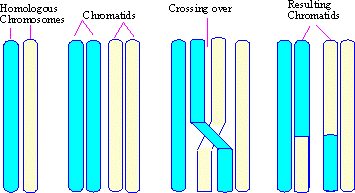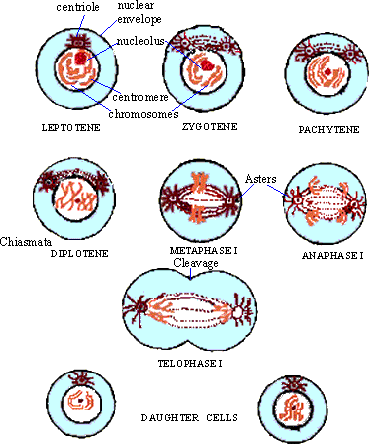|
PinkMonkey Online Study Guide-Biology
Prophase I. The prophase of meiosis 1 is much prolonged and can be divided further into five stages as follows:

Figure 14.17 Stages in crossing over
(i) Leptotene : The initial stage in which the
replication of DNA started in interphase continues. The nucleus enlarges
and the chromatin reticulum resolves into definite thread-like structures
called chromosomes. The identical or homologous chromosomes received from
the male and female parents become discernible.
(ii) Zygotene : In this stage the homologous chromosomes
begin to pair length to length and point to point in a zipper-
like manner. This pairing is called synapsis, and pairs are referred
to as bivalents formerly known as dyads (synapsis is absent in
mitosis).
(iii) Pachytene : The paired chromosomes at this stage become shorter and thicker. The chromosomes of each bivalent then split lengthwise to form four chromatids (tetrads).
(iv) Diplotene : The force of attraction between
the bivalents lapses; , however, they remain attached at certain points
called chiasmata where mutual exchange of parts, called crossing over,
can take place as shown in the figure 14. 17.
(v) Diakinesis : The shortening of chromosomes reaches its maximum. They assume characteristic forms depending upon the position of chiasmata. The nucleolus and nuclear membrane begin to disappear and spindle begins to appear.
Metaphase I : The spindle formation is complete. The
bivalents move and arrange themselves on equatorial plane. Each chromosome
of the bivalents gets attached to the spindle fiber at the centromere.
MEIOSIS-I

Figure 14.18 Cell Division: Meiosis I
Anaphase I : The two chromosomes, or mates,
of a bivalent (not the chromatids of the same chromosome) start moving
towards the opposite poles. Thus the real reduction in the number of chromosomes
takes place at this stage, each pole receiving half the number of original
chromosomes.
Telophase I : The chromosomes become long,
thread-like and indistinct. The nucleolus and the nuclear membrane reappear
thus forming two nuclei. The cytoplasm constricts in the middle to form
two daughter cells, each containing single nucleus with half the number
(haploid) of original number of chromosomes.
Usually cytokinesis does not occur immediately but the nuclei undergo second meiotic division. The interval between the two division is called interkinesis.
|